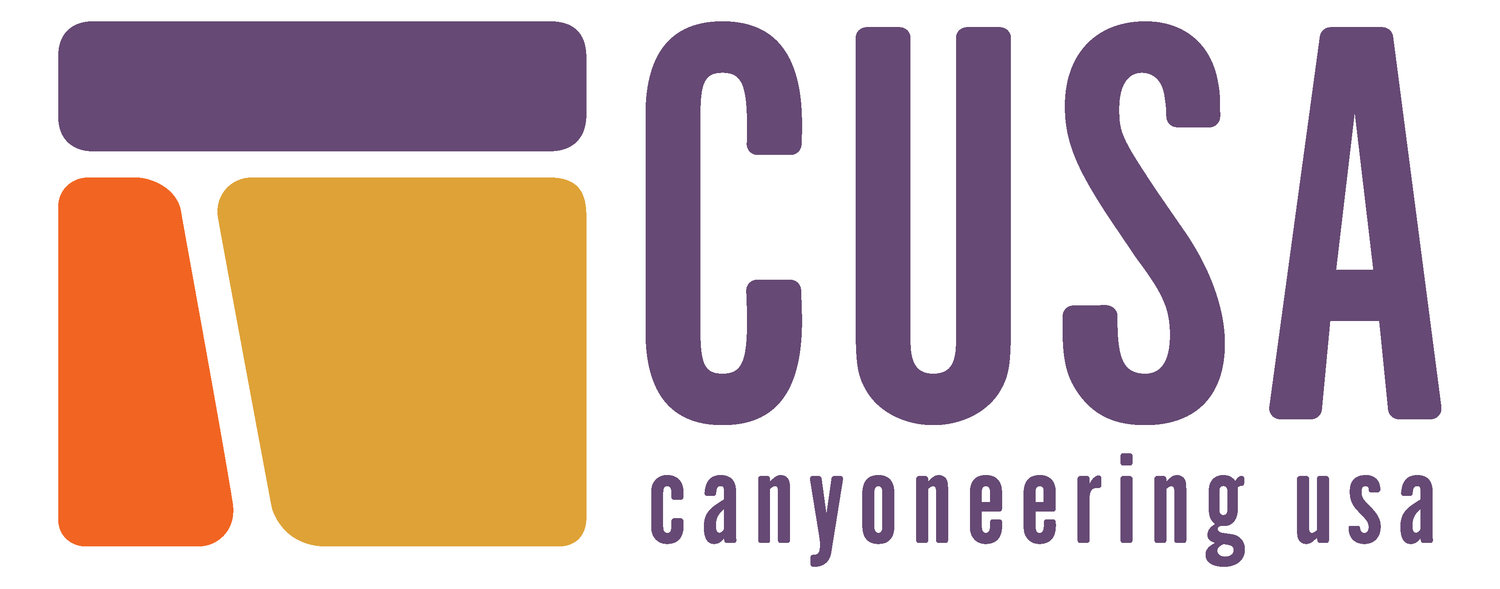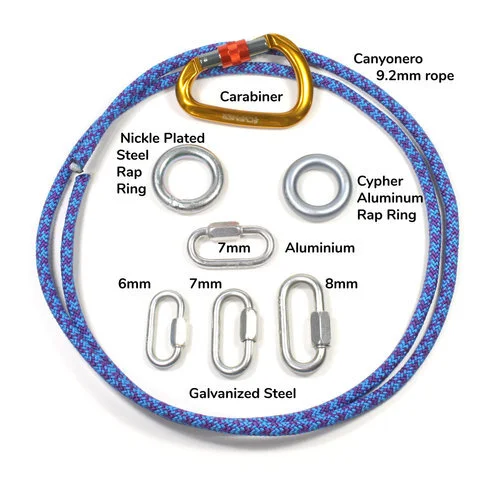Tom Rants about Rapid Links (Rapides, Maillons, Q/RLs, Quick Links)
CHAPTER ONE - SOME BACKGROUND NOMENCLATURE EXPLANATION
Question - Can someone explain the difference between safe working load and fall impact load? Or are they the same?
(Some people will want to start is this post by Richard Delany at Rope Test Lab: Carabiner Specifications
--- which covers the subject of carabiner specs and what they mean in detail and very clearly.)
WLL and SWL (working load limit and Safe Working Load) are two systems for rating hardware (and software) for industrial use. They apply to Rapid Links. It is a claim that under specific normal industrial lifting conditions, this item can be used (in a specific manner) for lifting a load up to the rated weight. If the WLL is 750 kg, and you need to lift your Lotus Europa Special (mass=740kg) out of the display case with a crane, you can use this item in the chain. IF your crane operator is a real crane operator and not your cousin Vinny who saw how to do it on YouTube.
Climbing gear is rated using an entirely different system. Manufacturers provide a Minimum Breaking Strength (MBS) which is the load that you can apply to the device without it breaking - though the load needs to be applied in exactly the way the item was tested.
For any specific item, the MBS can be calculated from the WLL or SWL by multiplying by the Safety Factor. The Safety factor takes account of what kind of loads are created on the item in reality when you lift your aged sportscar using a crane. But you would have to know the Safety Factor used for that specific item, which can vary. The lowest I have seen is 5X, and I am told some items might use 10X. The rapid links we are talking about use 5X, so they are 5 times stronger than the WLL stamped on the side.
The Fall Impact Load is the force generated by an object falling and then being caught by a rope, cable, lanyard, etc. More rigorously, we state a single number which is the highest force generated in the catch. This is a very difficult number to calculate, ... no, impossible is a better term. It is a hard number to measure, but it can be measured with proper equipment. If you are taking a fall of significant length, you want to be falling on a dynamic climbing rope, which has a carefully engineered stretch to it so that the Impact Load is minimized. Which helps things not break. Climbing rope designs are tested for the Impact Load they generate in a standardized test fall (a UIAA fall), which is about the worst fall one would expect (to survive) in the field.Thus when you buy a climbing rope, there is a number in its specifications that tell you what the rated Impact Force is on this rope, under extremely specific conditions, when new. Which is useful for comparing ropes, but not for much else.
But in the real world, Fall Impact loads are difficult to get a handle on. There are calculators available to estimate the Impact Load, but you have to enter numbers into the calculator which you probably don't know. If I say the catch was made in 0.1m, I get one answer, but if I say 0.2m, the answer I get is probably half that. If it is a human being caught, the squishiness of the human is not accounted for. The human is modeled as a collection of steel weights... and some of us might have the delusion that that models us well, but I don't. The squishiness in short falls probably reduces the Impact load by 50%. (Avoiding defining what a short fall is).
If your fall impact load exceeds the MBS of the carabiner, it is likely to break. If your fall impact load exceeds 5X the WLL of the rapide, it is likely to break.
CHAPTER TWO - RAPID LINKS
What you are looking for are Rapid Links (aka Rapides, Quick Links, Maillon Rapide, Links). Available in many styles and sizes. The cheap ones are junk, meaning, they have no brand name on them, and their quality varies widely... and they are not really made for life-safety applications. These no-brand rapides are often referred to as "Pacific Rim", and are available at Home Deport, Harbor Freight, etc... I recommend against using non-brand-name hardware for life safety applications.
I sell Rapides made by a French company with excellent quality control called Maillon Rapide. They come in many sizes, and the 7mm seems to be a good balance of weight vs. strength and working size. Some people use the 6mm (especially for explorations), but they are small enough that the fattest ropes people might take into canyons might get stuck in the pull. The 8mm size is good for high-use canyons, but they are heavy. Larger rapides are not only quite heavy, but also may be big enough to let a biner block slip through.
Galvanized Steel (carbon steel with a zinc coating) are what is normally used, and they normally last a long time. Canyons that have noxious chemicals in the water might destroy these quickly, but this is not too common. Quality stainless steel rapides are also available, but they cost about 5X as much. It is good to carry two or three rapides as a standard part of your kit to replace worn rapides you find on anchors.
Very few canyoners include a torque wrench in their kit, though some bring a 6" adjustable wrench... well, okay, Only me and a few former cavers. Rapides do not have "extra threads" so when they unscrew a bit (for instance when the rope is pulled through) they become very much weaker, and can open under load. This is especially true of the junky Pacific Rim links that may have bad machining in the first place, where 1 turn of the gate can un-close the threads. The best way to avoid this problem is to inspect the rapides you come to on anchors and make sure they are closed, with zero threads showing. Replace if necessary, that is why you brought some along.
Maillon Rapides are available at climbing stores or online at my CayoneeringUSA store.
There are EVEN BETTER rapid links available, sold by climbing companies like Metolius and Camp, that are CE certified for PPE (life-safety) applications. My opinion: these are the same rapid links I sell, but with additional quality control and you get a booklet explaining how to use them in 13 languages. They cost about twice as much.
Other shapes are available for specific applications, including for caving harnesses and paragliding. If you find these rigged in the field, get RID of them. Biner blocks can fall through them.
Aluminum rapides are available in limited sizes. They are 1/3 the weight, 3X the cost, and if used for rappelling anchors will wear out quickly. Not advised.
CHAPTER THREE - BOGUS IS BOGUS - QUALITY IS QUALITY
If I take a large paper clip and my micro-pen and write 2700 lbs on the Paper Clip, is it now a rated piece?
Of course not. This is pretty much what some manufacturers do, so buyer beware.
Stamping or laser-etching some numbers and letters onto an object does not make it a rated object. When you buy rapid links at Home Depot (or Harbor Freight) they may or may not have numbers and letter stamped on them; but they are unlikely to be certified to a standard or even have a manufacturers brand on them. Which means someone put some numbers on those rapides - and that is all it means.
Much of the life-safety equipment we use in canyoneering is certified to a standard and carries the CE mark (Conformité Européenne). This means that the design has met specific, rational strength and function criteria, and that it is manufactured in a facility that has a certified quality control process in place. You want stuff that your life depends on to meet this strict standard. But it is expensive, and not always necessary. (Certified rapid links are available in a couple of sizes, and available at some climbing stores under brand names Camp and Metolius (etc.)).
The next level of Quality is to buy a reputable brand name that has a certified quality system in place. The Rapides I sell are manufactured by Péguet Maillon Rapide made on the same machines and with the same materials as the Certified links they sell. My Imlay Canyon Gear ropes are not certified, but they are made in an ISO 9001 factory (a quality control certification). For my business, certifying my ropes would be expensive without adding value for the consumer - although it might open up selling to SAR operations that require certifications... but it is unclear that selling to those SAR groups would be either effective or a good idea.
The lowest level of Quality is "other". Low-quality rapid links may or may not have anything stamped on them, are unlikely to have a brand name, they might have a country of origin. Some even have "CE" stamped on them, which does not mean they conform to a European Standard - they SAY it means "China Export", wink wink nudge nudge... When these break, your survivors will be trying to sue China. Good luck with that.
Then again, Home Depot rapid links are made of steel, and steel is a strong, easy to work with material. And 8mm rapides from Home Depot are most likely just fine. Because even without good QC, they are likely to hold enough for our meager rappelling loads.
Story: I used to buy Rapides at Bolt and Nut Supply in Salt Lake City. Your basic "other" rapides. Using small ropes, we could use the 6mm size. I bought them there for a year or so, and was getting well-machined units. Then the next box I bought were real junk. The sleeve and body threads barely joined. We tested some and they were half the strength of the other 6mm rapides I was buying. I switched to buying from Peguet only.
My own choices are as follows:
1. I SELL non-CE rapides from Peguet. The price is reasonable, the quality is excellent.
2. I purchase (from myself) the same, and use those in the field.
3. I inspect in-situ rapid links and generally use the ones in place unless they are jacked. The ones out there in the field are rarely Peguet ones, usually are "other" rapides, but also usually fairly large. If they are corroded or poorly functioning I remove and replace.
A large point of this thread is to provide information so canyoneers can make intelligent informed choices.

